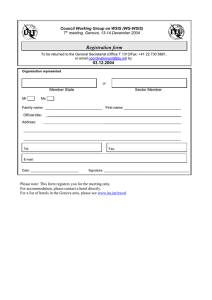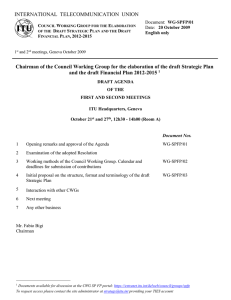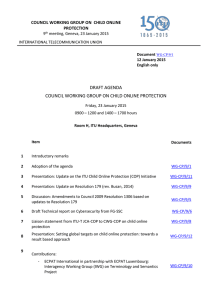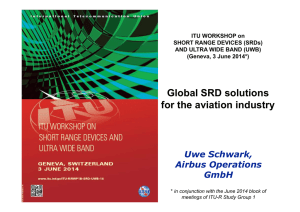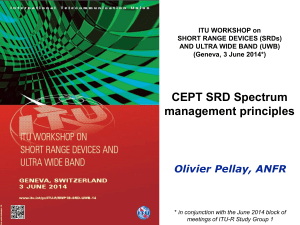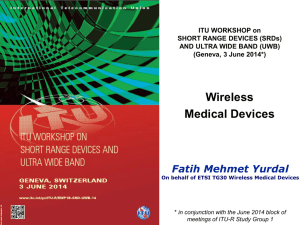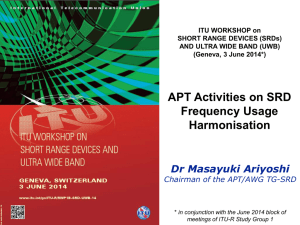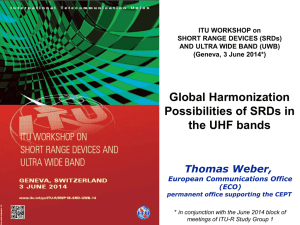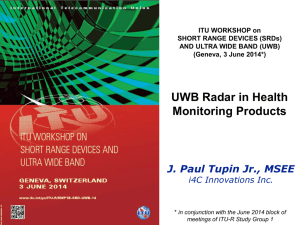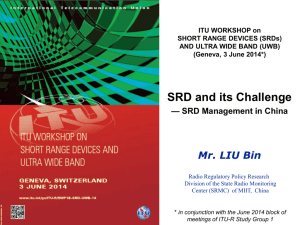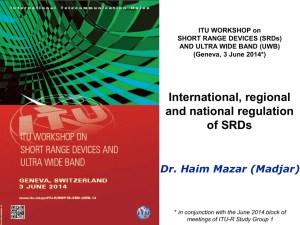RES-54 Lilian Jeanty The importance of SRD harmonization
advertisement
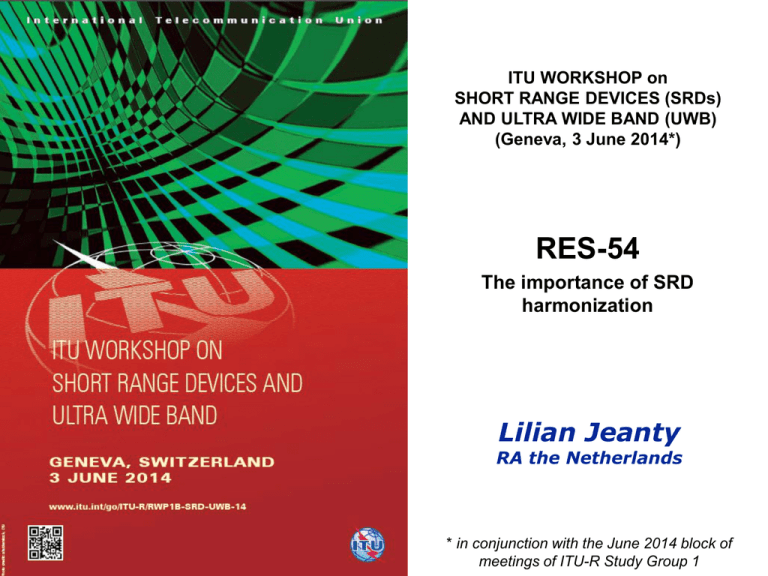
ITU WORKSHOP on SHORT RANGE DEVICES (SRDs) AND ULTRA WIDE BAND (UWB) (Geneva, 3 June 2014*) RES-54 The importance of SRD harmonization Lilian Jeanty RA the Netherlands International Telecommunication 2014 block of Union * in conjunction with the June meetings of ITU-R Study Group 1 Content Background to RES-54 The importance of RES-54 The challenge of finding a frequency band (an example) Conclusion ITU Workshop on Short Range Devices (SRDs) and Ultra Wide Band (UWB), 3 June 2014, Geneva 2 The start of harmonization (1) Before RA-07, an ITU-R Recommendation that did not recommend anything Collection of national/regional information RA-07 proposal for an ITU-R Resolution Reasons: economies of scale technological advances/ tuning ranges spectrum sharing integrated in consumer products/crossing borders ITU Workshop on Short Range Devices (SRDs) and Ultra Wide Band (UWB), 3 June 2014, Geneva 3 The start of harmonization (2) RA-07 adopted ITU-R Res 54 ITU-R Res 54 recommends studies enable implementation of advanced technologies for SRDs collect information SRD using advanced spectrum access/ tuning range techniques mechanism, that may ease the use of relevant frequency bands/ tuning ranges preferably on a global or regional basis ITU Workshop on Short Range Devices (SRDs) and Ultra Wide Band (UWB), 3 June 2014, Geneva 4 Studies after RA-07 WP 1B developed Rec ITU-R SM.1896 in 2011 contains frequency ranges to be used as recommended ranges for SRDs applications requiring operation on a global or regional harmonised basis Report ITU-R SM.2153 yearly updated RA-12 update of Res 54 study harmonization of technical and operating parameters study measurement procedures to verify these parameters study requirements SRD to promote efficient spectrum use study deployment in specific bands, harmonised globally or regionally ITU Workshop on Short Range Devices (SRDs) and Ultra Wide Band (UWB), 3 June 2014, Geneva 5 The challenge of finding a frequency band (1) Possible solutions for a product requiring worldwide use such as a hearing aid, medical implant or RFID/EAS system regulatory challenge Availability of tuning range in all countries Tuning range Conditions under which available Cognitive approach supported ? UWB Is the hardware suitable for use in a tuning range? What about local interference? Is global harmonization possible? QOS Are technical sharing solutions realistic ? (cost) What about local interference? Cognitive approach supported ? QOS Power levels not harmonised Is the specific deployment scenario allowed everywhere? Is the power level suitable? Are studies available for preferred band? Shared Frequency (band) technical challenge ITU Workshop on Short Range Devices (SRDs) and Ultra Wide Band (UWB), 3 June 2014, Geneva QOS 6 The challenge of finding a frequency band (2) Specific challenges for cognitive use regulatory challenge technical challenge Database availability Database responsibility Speed of sensing system Sensitivity of sensing system (receiver cost) High levels of integration restrict power supply Technical overhead in relation to product cost ITU Workshop on Short Range Devices (SRDs) and Ultra Wide Band (UWB), 3 June 2014, Geneva 7 The challenge of finding a frequency band (3) And what about ISM bands? Suitable for many applications Worldwide harmonised Sharing environment not suitable for all technologies / applications Interference from ISM equipment, unpredictable environment Unpredictable increased average noise level in ISM environment Frequency ranges limited in number and bandwidth ITU Workshop on Short Range Devices (SRDs) and Ultra Wide Band (UWB), 3 June 2014, Geneva 8 Conclusion First steps towards harmonization Important to continue studies Identify frequency bands Identify common technical and operating parameters Enable advanced technologies Strategy for the future? ITU Workshop on Short Range Devices (SRDs) and Ultra Wide Band (UWB), 3 June 2014, Geneva 9 ITU Workshop on Short Range Devices (SRDs) and Ultra Wide Band (UWB), 3 June 2014, Geneva 10
